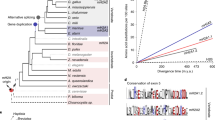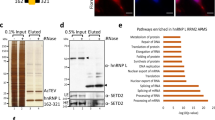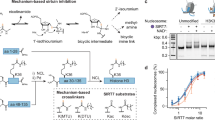Abstract
Histone macroH2A is a hallmark of mammalian heterochromatin. Here we show that human macroH2A1.1 binds the SirT1-metabolite O-acetyl-ADP-ribose (OAADPR) through its macro domain. The 1.6-Å crystal structure and mutants reveal how the metabolite is recognized. Mutually exclusive exon use in the gene H2AFY produces macroH2A1.2, whose tissue distribution differs. MacroH2A1.2 shows only subtle structural changes but cannot bind nucleotides. Alternative splicing may thus regulate the binding of nicotinamide adenine dinucleotide (NAD) metabolites to chromatin.
This is a preview of subscription content, access via your institution
Access options
Subscribe to this journal
Receive 12 print issues and online access
$209.00 per year
only $17.42 per issue
Buy this article
- Purchase on SpringerLink
- Instant access to full article PDF
Prices may be subject to local taxes which are calculated during checkout


Similar content being viewed by others
References
Pehrson, J.R. & Fried, V.A. Science 257, 1398–1400 (1992).
Allen, M.D., Buckle, A.M., Cordell, S.C., Lowe, J. & Bycroft, M. J. Mol. Biol. 330, 503–511 (2003).
Ladurner, A.G. Mol. Cell 12, 1–3 (2003).
Costanzi, C. & Pehrson, J.R. Nature 393, 599–601 (1998).
Zhang, R. et al. Dev. Cell 8, 19–30 (2005).
Grigoryev, S.A., Nikitina, T., Pehrson, J.R., Singh, P.B. & Woodcock, C.L. J. Cell Sci. 117, 6153–6162 (2004).
Karras, G.I. et al. EMBO J. 24, 1911–1920 (2005).
Kim, M.Y., Mauro, S., Gevry, N., Lis, J.T. & Kraus, W.L. Cell 119, 803–814 (2004).
Rosenberg, M.I. & Parkhurst, S.M. Cell 109, 447–458 (2002).
Vaquero, A. et al. Mol. Cell 16, 93–105 (2004).
Smith, J.S. et al. Proc. Natl. Acad. Sci. USA 97, 6658–6663 (2000).
Landry, J. et al. Proc. Natl. Acad. Sci. USA 97, 5807–5811 (2000).
Imai, S., Armstrong, C.M., Kaeberlein, M. & Guarente, L. Nature 403, 795–800 (2000).
Jackson, M.D. & Denu, J.M. J. Biol. Chem. 277, 18535–18544 (2002).
Pehrson, J.R., Costanzi, C. & Dharia, C. J. Cell. Biochem. 65, 107–113 (1997).
Bordone, L. & Guarente, L. Nat. Rev. Mol. Cell Biol. 6, 298–305 (2005).
Acknowledgements
We thank M. Wilm for mass spectrometry; G. Karras, A. Bianco, G. Stier, H. Buhecha, M. Breitenbach and H. Koller for assorted help; S. Fribourg for beamline data collection; A. Akhtar, E. Conti, E. Izaurralde, C. Margulies, I. Mattaj, J. Müller and C. Schultz for discussion; and the staff at beamline ID14-1/ID14-4 of the ESRF for technical support. M.H. acknowledges financial support from the Peter and Traudl Engelhorn Foundation, Germany.
Author information
Authors and Affiliations
Corresponding authors
Ethics declarations
Competing interests
The authors declare no competing financial interests.
Supplementary information
Supplementary Fig. 1
Schematic group II intron secondary structure. (PDF 460 kb)
Supplementary Fig. 2
The products of splicing from a D56 molecule containing a single-nucleotide 3′-exon. (PDF 445 kb)
Supplementary Table 1
Data collection and refinement statistics (Molecular Replacement). (PDF 75 kb)
Rights and permissions
About this article
Cite this article
Kustatscher, G., Hothorn, M., Pugieux, C. et al. Splicing regulates NAD metabolite binding to histone macroH2A. Nat Struct Mol Biol 12, 624–625 (2005). https://doi.org/10.1038/nsmb956
Received:
Accepted:
Published:
Issue Date:
DOI: https://doi.org/10.1038/nsmb956
This article is cited by
-
The diagnostic and prognostic value of H2AFY in hepatocellular carcinoma
BMC Cancer (2021)
-
Evolution of a histone variant involved in compartmental regulation of NAD metabolism
Nature Structural & Molecular Biology (2021)
-
Biomimetic α-selective ribosylation enables two-step modular synthesis of biologically important ADP-ribosylated peptides
Nature Communications (2020)
-
The roles of histone variants in fine-tuning chromatin organization and function
Nature Reviews Molecular Cell Biology (2020)
-
Zebrafish macroH2A variants have distinct embryo localization and function
Scientific Reports (2019)



